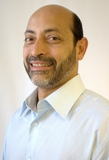Umesh K. Mishra: Difference between revisions
(Created page with "== Biography == Professor and associate dean of the College of Engineering at the University of California in Santa Barbara, Umesh Mishra is a leader in developing compound sem...") |
No edit summary |
||
| (6 intermediate revisions by 3 users not shown) | |||
| Line 1: | Line 1: | ||
== | {{Biography | ||
|Image=Mishra.jpg | |||
|Associated organizations=University of California | |||
|Fields of study=Transistors | |||
|Awards=[[IEEE Jun-ichi Nishizawa Medal]] | |||
}} | |||
Professor and associate dean of the College of Engineering at the University of California in Santa Barbara, Umesh Mishra is a leader in developing compound semiconductor electronics and a driving force behind the rapid progress in gallium nitride (GaN)-based microwave devices and circuits. | |||
He began his career researching gallium arsenide and indium phosphide (InP) high electron mobility [[Transistors|transistors]] (HEMTs) for low noise amplifiers, which became the leading receiver technology for many space-based platforms. Dr. Mishra’s research group was the first to demonstrate that the unique wide bandgap and electron transport properties of gallium nitride could be harnessed to create devices with an unprecedented combination of high-frequency performance and microwave power output. Since then, Dr. Mishra has continued to make key advances in both the fundamental understanding and the technological exploitation of GaN/A1GaN HEMT devices. | |||
An [[IEEE Fellow Grade History|IEEE Fellow]], Dr. Mishra has a bachelor’s from the Indian Institute of Technology in Kanpur, India, a master’s from Lehigh University in Bethlehem, PA, and a doctorate from Cornell University in Ithaca, NY, all in electrical engineering. | |||
[[Category:Electron devices]] | |||
[[Category:Semiconductor devices]] | |||
[[Category:Gallium compounds]] | |||
{{DEFAULTSORT:Mishra}} | |||
Latest revision as of 20:55, 21 January 2022
- Associated organizations
- University of California
- Fields of study
- Transistors
- Awards
- IEEE Jun-ichi Nishizawa Medal
Biography
Professor and associate dean of the College of Engineering at the University of California in Santa Barbara, Umesh Mishra is a leader in developing compound semiconductor electronics and a driving force behind the rapid progress in gallium nitride (GaN)-based microwave devices and circuits.
He began his career researching gallium arsenide and indium phosphide (InP) high electron mobility transistors (HEMTs) for low noise amplifiers, which became the leading receiver technology for many space-based platforms. Dr. Mishra’s research group was the first to demonstrate that the unique wide bandgap and electron transport properties of gallium nitride could be harnessed to create devices with an unprecedented combination of high-frequency performance and microwave power output. Since then, Dr. Mishra has continued to make key advances in both the fundamental understanding and the technological exploitation of GaN/A1GaN HEMT devices.
An IEEE Fellow, Dr. Mishra has a bachelor’s from the Indian Institute of Technology in Kanpur, India, a master’s from Lehigh University in Bethlehem, PA, and a doctorate from Cornell University in Ithaca, NY, all in electrical engineering.
